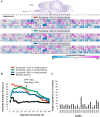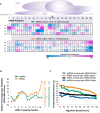Functional features defining the efficacy of cholesterol-conjugated, self-deliverable, chemically modified siRNAs
- PMID: 30169779
- PMCID: PMC6237813
- DOI: 10.1093/nar/gky745
Functional features defining the efficacy of cholesterol-conjugated, self-deliverable, chemically modified siRNAs
Abstract
Progress in oligonucleotide chemistry has produced a shift in the nature of siRNA used, from formulated, minimally modified siRNAs, to unformulated, heavily modified siRNA conjugates. The introduction of extensive chemical modifications is essential for conjugate-mediated delivery. Modifications have a significant impact on siRNA efficacy through interference with recognition and processing by RNAi enzymatic machinery, severely restricting the sequence space available for siRNA design. Many algorithms available publicly can successfully predict the activity of non-modified siRNAs, but the efficiency of the algorithms for designing heavily modified siRNAs has never been systematically evaluated experimentally. Here we screened 356 cholesterol-conjugated siRNAs with extensive modifications and developed a linear regression-based algorithm that effectively predicts siRNA activity using two independent datasets. We further demonstrate that predictive determinants for modified and non-modified siRNAs differ substantially. The algorithm developed from the non-modified siRNAs dataset has no predictive power for modified siRNAs and vice versa. In the context of heavily modified siRNAs, the introduction of chemical asymmetry fully eliminates the requirement for thermodynamic bias, the major determinant for non-modified siRNA efficacy. Finally, we demonstrate that in addition to the sequence of the target site, the accessibility of the neighboring 3' region significantly contributes to siRNA efficacy.
Figures






Similar articles
-
Comparison of partially and fully chemically-modified siRNA in conjugate-mediated delivery in vivo.Nucleic Acids Res. 2018 Mar 16;46(5):2185-2196. doi: 10.1093/nar/gky037. Nucleic Acids Res. 2018. PMID: 29432571 Free PMC article.
-
siRNA function in RNAi: a chemical modification analysis.RNA. 2003 Sep;9(9):1034-48. doi: 10.1261/rna.5103703. RNA. 2003. PMID: 12923253 Free PMC article.
-
The potency of siRNA-mediated growth inhibition following silencing of essential genes is dependent on siRNA design and varies with target sequence.Oligonucleotides. 2009 Dec;19(4):317-28. doi: 10.1089/oli.2009.0207. Oligonucleotides. 2009. PMID: 19943803
-
Polyethylenimines for RNAi-mediated gene targeting in vivo and siRNA delivery to the lung.Eur J Pharm Biopharm. 2011 Apr;77(3):438-49. doi: 10.1016/j.ejpb.2010.11.007. Epub 2010 Nov 18. Eur J Pharm Biopharm. 2011. PMID: 21093588 Review.
-
Recent progress in chemically modified siRNAs.Mini Rev Med Chem. 2010 Jun;10(7):578-95. doi: 10.2174/138955710791384036. Mini Rev Med Chem. 2010. PMID: 20500149 Review.
Cited by
-
Structural Modifications of siRNA Improve Its Performance In Vivo.Int J Mol Sci. 2023 Jan 4;24(2):956. doi: 10.3390/ijms24020956. Int J Mol Sci. 2023. PMID: 36674473 Free PMC article. Review.
-
Releasing the Immune System Brakes Using siRNAs Enhances Cancer Immunotherapy.Cancers (Basel). 2019 Feb 3;11(2):176. doi: 10.3390/cancers11020176. Cancers (Basel). 2019. PMID: 30717461 Free PMC article. Review.
-
The clinical potential of l-oligonucleotides: challenges and opportunities.Chem Sci. 2024 Oct 21;15(44):18239-58. doi: 10.1039/d4sc05157b. Online ahead of print. Chem Sci. 2024. PMID: 39479156 Free PMC article. Review.
-
Di-valent siRNA-mediated silencing of MSH3 blocks somatic repeat expansion in mouse models of Huntington's disease.Mol Ther. 2023 Jun 7;31(6):1661-1674. doi: 10.1016/j.ymthe.2023.05.006. Epub 2023 May 12. Mol Ther. 2023. PMID: 37177784 Free PMC article.
-
Introducing an In Vitro Liver Stability Assay Capable of Predicting the In Vivo Pharmacodynamic Efficacy of siRNAs for IVIVC.Mol Ther Nucleic Acids. 2020 Sep 4;21:725-736. doi: 10.1016/j.omtn.2020.07.012. Epub 2020 Jul 10. Mol Ther Nucleic Acids. 2020. PMID: 32771924 Free PMC article.
References
-
- Dowdy S.F. Overcoming cellular barriers for RNA therapeutics. Nat. Biotechnol. 2017; 35:222–229. - PubMed
-
- Huesken D., Lange J.A., Mickanin C., Weiler J., Asselbergs F., Warner J., Meloon B., Engel S., Rosenberg A., Cohen D. et al. . Design of a genome-wide siRNA library using an artificial neural network. Nat. Biotechnol. 2005; 23:995–1001. - PubMed
Publication types
MeSH terms
Substances
Grants and funding
LinkOut - more resources
Full Text Sources
Other Literature Sources
Medical
Molecular Biology Databases
Miscellaneous

